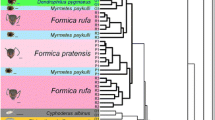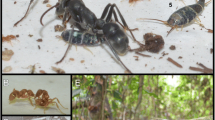Abstract
Chemical recognition systems are crucial for maintaining the unity of social insect colonies. It has been proposed that colonies form a common chemical signature, called the gestalt odor, which is used to distinguish colony members and non-members. This chemical integration is achieved actively through social interactions such as trophallaxis and allogrooming, or passively such as through exposure to common nest material. When colonies are infiltrated by social parasites, the intruders often use some form of chemical mimicry. However, it is not always clear how this chemical mimicry is accomplished. Here, we used a three-species nesting symbiosis to test the differences in chemical integration of mutualistic (parabiotic) and parasitic ant species. We found that the parasite (Solenopsis picea) obtains chemical cues from both of the two parabiotic host ant species. However, the two parabiotic species (Crematogaster levior and Camponotus femoratus) maintain species-specific cues, and do not acquire compounds from the other species. Our findings suggest that there is a fundamental difference in how social mutualists and social parasites use chemicals to integrate themselves into colonies.


Similar content being viewed by others
References
Akino T, Tsuneoka Y (2012) Chemical camouflage of the slave-making ant Polyergus samurai queen in the process of the host colony usurpation (Hymenoptera: Formicidae). Chemoecology 22:89–99
Bauer S, Böhm M, Witte V, Foitzik S (2009) An ant social parasite in-between two chemical disparate host species. Evol Ecol 24:317–332
Beye M, Neumann P, Moritz R (1997) Nestmate recognition and the genetic gestalt in the mound-building ant Formica polyctena. Insect Soc 44:49–58
Bos N, D’Ettorre P (2012) Recognition of social identity in ants. Front Psychol 3:1–6
Bos N, Grinsted L, Holman L (2011) Wax on, wax off: nest soil facilitates indirect transfer of recognition cues between ant nestmates. PLoS One 6, e19435
Brandt M, Foitzik S, Fischer-Blass B (2005) The coevolutionary dynamics of obligate ant social parasite systems – between prudence and antagonism. Biol Rev 80:251–267
Brandt M, van Wilgenburg E, Sulc R (2009) The scent of supercolonies: the discovery, synthesis and behavioural verification of ant colony recognition cues. BMC Biol 7:71–80
Breed MD, Butler L, Stiller TM (1985) Kin discrimination by worker honey bees in genetically mixed groups. Proc Natl Acad Sci U S A 82:3058–3061
Buschinger A (2009) Social parasitism among ants: a review (Hymenoptera: Formicidae). Myrmecol News 12:219–235
Carlin NF, Hölldobler B (1983) Nestmate and kin recognition in interspecific mixed colonies of ants. Science 222:1027–1029
Davidson DW (2005) Ecological stoichiometry of ants in a New World rain forest. Oecologia 142:221–231
D’Ettorre P, Mondy N (2002) Blending in with the crowd: social parasites integrate into their host colonies using a flexible chemical signature. Proc R Soc B: Biol Sci 269:1911–1918
D’Ettorre P, Brunner E, Wenseleers T, Heinze J (2004) Knowing your enemies: seasonal dynamics of host–social parasite recognition. Naturwissenschaften 91:594–597
Dixon P (2003) VEGAN, a package of R functions for community ecology. J Veg Sci 14:927–930
Drescher J, Blüthgen N, Schmitt T, Bühler J, Feldhaar H (2010) Societies drifting apart? Behavioural, genetic and chemical differentiation between supercolonies in the yellow crazy ant Anoplolepis gracilipes. PLoS One 5, e13581
Emery VJ, Tsutsui ND (2013) Recognition in a social symbiosis: chemical phenotypes and nestmate recognition behaviors of Neotropical parabiotic ants. PLoS One 8, e56492
Errard C, Hefetz A (1997) Label familiarity and discriminatory ability of ants reared in mixed groups. Insect Soc 44:189–198
Errard C, Hefetz A, Jaisson P (2005) Social discrimination tuning in ants: template formation and chemical similarity. Behav Ecol Sociobiol 59:353–363
Fürst MA, Durey M, Nash DR (2012) Testing the adjustable threshold model for intruder recognition on Myrmica ants in the context of a social parasite. Proc R Soc Lond B 279:516–522
Gibbs AG (2002) Lipid melting and cuticular permeability: new insights into an old problem. J Insect Physiol 48:391–400
Goslee SC, Urban DL (2007) The ecodist package for dissimilarity-based analysis of ecological data. J Stat Software 22:1–19
Guillem RM, Drijfhout F, Martin SJ (2014) Chemical deception among ant social parasites. Curr Zool 60:62–75
Hoffmann F, Separation E, Modified W, Hefetz A, Errard C, Cojocaru M (1992) Heterospecific substances in the postpharyngeal gland secretion of ants reared in mixed groups. Naturwissenschaften 79:417–420
Huang MH, Dornhaus A (2008) A meta-analysis of ant social parasitism: host characteristics of different parasitism types and a test of Emery’s rule. Ecol Entomol 33:589–596
Katritzky AR, Chen K, Maran U, Carlson DA (2000) QSPR correlation and predictions of GC retention indexes for methyl-branched hydrocarbons produced by insects. Anal Chem 72:101–109
Lehmann L, Perrin N (2002) Altruism, dispersal, and phenotype-matching kin recognition. Am Nat 159:451–468
Lenoir A, Malosse C, Yamaoka R (1997) Chemical mimicry between parasitic ants of the genus Formicoxenus and their host Myrmica (Hymenoptera: Formicidae). Biochem Syst Ecol 25:379–389
Lenoir A, Ettorre PD, Errard C, D’Ettorre P, Hefetz A (2001) Chemical ecology and social parasitism in ants. Annu Rev Entomol 46:573–599
Longino J (2003) The Crematogaster (Hymenoptera, Formicidae, Myrmicinae) of Costa Rica. Zootaxa 150:1–150
Lorenzi MC, Bagnères AG (2002) Concealing identity and mimicking hosts: a dual chemical strategy for a single social parasite? (Polistes atrimandibularis, Hymenoptera: Vespidae). Parasitology 125:507–512
Mann WM (1912) Parabiosis in Brazilian ants. Psyche J Entomol 19:36–41
Martin S, Drijfhout F (2009) A review of ant cuticular hydrocarbons. J Chem Ecol 35:1151–1161
Martin SSJ, Helanterä H, Drijfhout FP (2008) Evolution of species-specific cuticular hydrocarbon patterns in Formica ants. Biol J Linn Soc 95:131–140
Martin SJ, Shemilt S, Drijfhout FP (2012) Effect of time on colony odour stability in the ant Formica exsecta. Naturwissenschaften 99:327–331
Mateo JM (2002) Kin-recognition abilities and nepotism as a function of sociality. Proc R Soc Lond B 269:721–727
Mateo JM, Holmes WG (2004) Cross-fostering as a means to study kin recognition. Anim Behav 68:1451–1459
Menzel F, Blüthgen N (2010) Parabiotic associations between tropical ants: equal partnership or parasitic exploitation? J Anim Ecol 79:71–81
Menzel F, Schmitt T (2011) Tolerance requires the right smell: first evidence for interspecific selection on chemical recognition cues. Evolution 66:869–904
Menzel F, Schmitt T (2012) Tolerance requires the right smell: first evidence for interspecific selection on chemical recognition cues. Evolution 66:896–904
Menzel F, Linsenmair KE, Blüthgen N (2008) Selective interspecific tolerance in tropical Crematogaster–Camponotus associations. Anim Behav 75:837–846
Menzel F, Schmitt T, Blüthgen N (2009) Intraspecific nestmate recognition in two parabiotic ant species: acquired recognition cues and low inter-colony discrimination. Insect Soc 56:251–260
Orivel J, Errard C, Dejean A (1997) Ant gardens : interspecific in parabiotic ant species recognition. Behav Ecol Sociobiol 40:87–93
Pacheco JA (2007) The new world thief ants of the genus Solenopsis (Hymenoptera: Formicidae). Dissertation. University of Texas, El Paso, USA
R Development Core Team R (2011) R: a language and environment for statistical computing. R J
Richard F-J, Hunt JH (2013) Intracolony chemical communication in social insects. Insect Soc 60:275–291
Sheehan MJ, Tibbetts EA (2011) Specialized face learning is associated with individual recognition in paper wasps. Science 334:1272–1275
Sturgis S, Gordon D (2012) Nestmate recognition in ants (Hymenoptera: Formicidae): a review. Myrmecol News 16:101–110
Tibbetts E (2002) Visual signals of individual identity in the wasp Polistes fuscatus. Proc Roy Soc London 269:1423–1428
Tsutsui N (2004) Scents of self: the expression component of self/non-self recognition systems. Ann Zool Fenn: 713–727
Turillazzi S, Sledge MF, Dani FR, Cervo R, Massolo A (2000) Social hackers: integration in the host chemical recognition system by a paper wasp social parasite. Naturwissenschaften 87:172–176
Van Zweden JS, Brask JB, Christensen JH, Boomsma JJ, Linksvayer TA, d’Ettorre P (2010) Blending of heritable recognition cues among ant nestmates creates distinct colony gestalt odours but prevents within-colony nepotism. J Evol Biol 23:1498–1508
Vienne C, Soroker V, Hefetz A (1995) Congruency of hydrocarbon patterns in heterospecific groups of ants: transfer and/or biosynthesis? Insect Soc 277:267–277
von Beeren C (2012) Social integration of macroparasites in ant societies: ultimate and proximate mechanisms. Dissertation. LMU Munchen, Germany
Weber N (1943) Parabiosis in neotropical “ant gardens”. Ecology 24:400–404
Wheeler W (1921) A new case of parabiosis and the “ant gardens” of British Guiana. Ecology 59:89–103
Acknowledgments
We thank Celeste Sandoval and Alain Dejean for help in the field; Jeannot and Odette Morvan at Camp Patawa for lodgings in French Guiana; Stephanie Kung, Judy Chung, Larissa Walder, and Camila Torres for help with lab work. Funding for this research was provided by the American Association for the Advancement of Science Pacific Division Alan E. Leviton Student Research Award, the Society for Integrative and Comparative Biology Fellowship for Graduate Student Travel, the Margaret C. Walker Fund for Teaching and Research in Systematic Entomology, the Johannes Joos Fund, and a Post-Graduate Fellowship from the Natural Sciences and Engineering Research Council of Canada (NSERC) to VJE. This work was also supported by the USDA National Institute of Food and Agriculture, Hatch project CA-B-INS-0087-H. The funders had no role in study design, data collection and analysis, decision to publish, or preparation of the manuscript.
Author information
Authors and Affiliations
Corresponding author
Rights and permissions
About this article
Cite this article
Emery, V.J., Tsutsui, N.D. Differential Sharing of Chemical Cues by Social Parasites Versus Social Mutualists in a Three-Species Symbiosis. J Chem Ecol 42, 277–285 (2016). https://doi.org/10.1007/s10886-016-0692-0
Received:
Revised:
Accepted:
Published:
Issue Date:
DOI: https://doi.org/10.1007/s10886-016-0692-0




